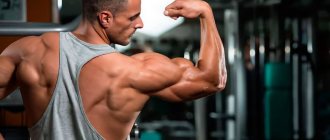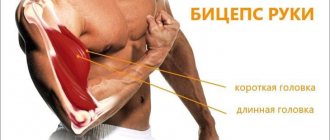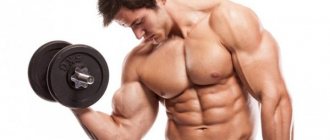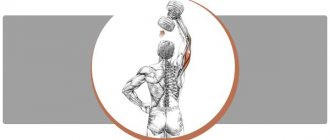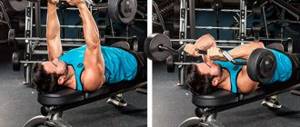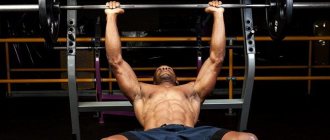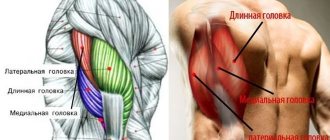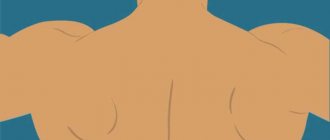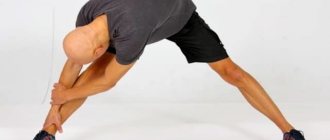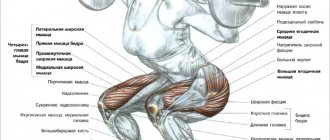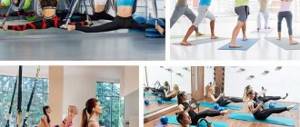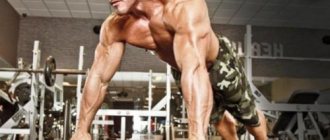Hands are one of the most necessary parts of the body. And one of the most popular for building muscle mass. But before you start pumping your arms, you need to learn about their structure, anatomy and which muscles work during certain movements and what they are responsible for. It will also be helpful for you to read the previous article on the anatomy of the pectoral muscles.
So, in this article we will tell you about the structure and anatomy of the arm muscles. The hands consist of numerous muscles, both large ones that we see with the naked eye, and more hidden ones, but no less important.
If you visually divide the arm into two parts, then in the upper one you can distinguish a group of muscles of the shoulder, and in the lower one - a group of muscles of the forearm. The arm muscles are primarily responsible for extension and flexion. Let's look at the anatomy of each arm muscle separately.
Digression from the topic: look for the best exercise for training the inner thigh - the plie squat!
MUSCLES OF THE FOREARM
The forearm in its normal state is club-shaped with a flattened anterior and posterior surface. In the upper part of the forearm there are, for the most part, the belly of the muscles, in the lower part, mainly their tendons. In muscular people, the shape of the forearm can change to a large extent due to muscle contraction. A thin and narrow lower forearm indicates a weaker skeleton. The tendons of the superficial muscles appear quite clearly. The muscle ridges and grooves of the forearm are more noticeable the more muscular a person is and the less body fat he has.
From an anatomical point of view, the muscles of the forearm are divided into three groups. Some of them are responsible for wrist movements, while others are responsible for finger movements. In front, on the side of the palm, there is a group of flexors. On the opposite side are the extensors. The third group of muscles is located in the area of the thumb.
Muscles that flex the arm at the wrist joint:
- Palmaris longus muscle
- Flexor carpi radialis
- Flexor carpi ulnaris
Muscles that flex the fingers:
- Flexor digitorum superficialis
- Flexor digitorum profundus
- Flexor pollicis longus.
Of the muscles on which the outline of the forearm depends, mention should be made of the pronator teres, which has the shape of an oblong, not particularly convex roller, located on the inside of the cubital fossa. The pronator is involved in two movements of the forearm - flexion and pronation (internal rotation) along with the following muscles: flexor carpi radialis, palmaris longus, flexor digitorum superficialis, flexor carpi ulnaris. The pronator starts from the inner condyle of the humerus and is attached in the wrist to the phalanges of the fingers from the palmar surface of the hand. The above muscles form elongated muscle ridges, which are noticeable when the hand is bent at the wrist towards the palm and little finger.
Muscles that extend the arm at the wrist joint:
- Extensor carpi radialis longus
- Extensor carpi radialis brevis
- Extensor carpi ulnaris
Muscles that extend the fingers:
- Extensor digitorum
- Extensor pollicis longus
- Extensor pollicis brevis
- Extensor index finger
The extensors are located on the back of the forearm. Covered only by thin skin, they are clearly visible in muscular people. The prominent muscles primarily include the extensors of the little finger and index finger, the extensor carpi ulnaris, the abdomen of which is especially clearly visible along the edge of the ulna. In addition, the same group of muscles includes the long and short extensors of the thumb and its long abductor muscle. All of the above muscles make it possible to bend the hand towards its back, move the hand towards the thumb and little finger, and extend the fingers. Other muscles are grouped near the radius. The extensor carpi brevis and longus muscles are clearly visible when clenching your hands into a fist, when they contribute to the dorsiflexion of the hand at the wrist, which, in turn, allows the flexors to clench the fingers more tightly into a fist.
Core muscles of the arms
The biceps is the biceps muscle of the upper arm, connected to the elbow joint by ligaments and tendons.
It consists of two muscle heads: short (large muscle and short tendon) and long (small muscle). Both originate on the shoulder blade, only in different places, they unite in the middle of the shoulder, and below they are connected to the round eminence of the forearm bone. People who regularly perform hard physical work and athletes who are actively involved in the gym always have well-developed biceps. After all, the main function of the biceps muscle is raising and bending the arms. Turning your palms inward and moving them upward causes the biceps to work as an instep support for the forearm.
The triceps consists of three muscle heads, which when developed form a horseshoe shape:
- Lateral (external) head.
It runs down the back of the arm from the humerus to the olecranon and makes up the outer side of the upper arm. - The medial (middle) head
originates on the back of the humerus and attaches to the elbow. - The long (inner) head
begins in the region of the humerus and descends down to the olecranon process, partially covered by the other two heads.
The triceps muscle of the arm is responsible for abducting the shoulder from the body, extending the elbow joint (helps straighten the arm) and bringing the arms towards the body.
The triceps ligament of all three bundles can be short (the muscle is more massive) or long (the triceps looks short and peaked). These are features of the genetics of each person individually and cannot be changed in any way. The muscles of the forearm consist of two muscle groups: anterior (flexors), posterior (extensors and supinators). The largest muscles in this area are the brachialis, brachyradialis, coracoid, and flexor carpi radialis longus.
In order to maximally involve the target muscles in the work, it is necessary to have an idea of which joints and bones are involved, and what work is assigned to them.
Biceps training is influenced by three important joints on the front of the arm: the shoulder, which is crossed by the long head of the biceps; ulnar, involved in flexion of the elbow joint when lifting the biceps, as well as in the rotation and rotation of the arms; carpal, responsible for changing the position of the forearms and involved in pronation/supination. These same three key joints work when training the triceps. The shoulder joint is used when raising the arms, the elbow joint when extending the arms from behind the head.
see also
Back muscles: structure and functions
The back muscles occupy the largest surface area of the body compared to other muscle groups. Thanks to the muscles of the back, a person has the ability to walk upright on two legs, which distinguishes humans from animals.
Chest muscles: structure and functions
The pectoral muscles occupy most of the upper surface of the body and are clearly visible from the front. Every man strives to give his chest muscles mass and definition, since these muscles greatly influence the overall appearance.
Abdominal muscles: structure and functions
The abdominal muscles occupy a large surface area and perform a number of important functions of the body. A clear, sculpted press is one of the indicators of good shape. However, a lot of fat deposits usually accumulate in the abdominal area, so.
Muscles of the shoulder girdle: structure and functions
Description of the composition and functions of the main muscles of the shoulder girdle. The muscles that are responsible for flexion and extension of the arm at the shoulder joint, abduction and extension of the arms, as well as inward rotation of the arms, etc.
The triceps is one of the main muscles of the arm, both anatomically and externally. Its essence is that it extends the arm and helps the biceps manipulate the arm: when flexing. That is, it is not enough to simply have developed biceps to perform some strength elements. Triceps are a significant part of the entire arm's work. It not only extends the arm and helps with lifting, but also protects the joints from stress. And also, if you pump only the biceps, you will get a sloppy appearance and a disproportionate arm.
Exercises for the forearm
- Barbell curl with overhand grip. This exercise works the wrist extensor ; Extensor carpi radialis longus, extensor carpi radialis brevis, extensor digitorum, extensor carpi ulnaris, and extensor carpi ulnaris.
- Overhand grip barbell wrist extension. This exercise strengthens the wrist joints, which are often weak due to insufficient wrist extensor muscle strength.
- Barbell wrist curl with an underhand grip. This exercise trains the flexor carpi , palmaris longus, flexor carpi ulnaris, and deep and superficial digital flexors, which, despite being deep, typically make up the bulk of the total wrist flexor workload.
Video of wrist extension with barbell overhand grip
Anatomy of the triceps brachii muscle
The structure of the triceps is shaped like a horseshoe. This is the back surface of the arm, which extends from the shoulder to the elbow joint. The triceps, as the name suggests, consists of three heads: long, lateral and medial.
- The long head of the triceps is attached to the subarticular tubercle of the scapula and is located on the inside of the arm.
- The lateral head of the triceps is a long muscle that occupies almost 2/3 of the entire triceps. It originates from the shoulder bundle and is located on the outside.
- The medial head of the triceps is stretched from the back of the humerus to the elbow joint. This is the smallest muscle that divides the other two at the top, but connects them at the bottom, thereby forming something like the letter “v”.
Anatomy and structure of the biceps of the arm
Biceps. One of the most famous muscles. If someone finds out that you are pumping your arms, they immediately ask you to show this particular muscle. The muscle consists of two heads located in the upper part of the arm, originating at the shoulder and ending at the elbow. What does a muscle do:
- bends the arm;
- turns his hand palm up.
Triceps function
The main function of the muscle is to extend the arm at the elbow joint. Just like the biceps helps flex the forearm, the triceps returns the arm to its starting position. Also, it allows you to protect your joints from heavy loads. The latter function is best handled by the medial head of the triceps. In addition, the triceps helps the shoulder bring the arm towards the body, due to the fact that the length of the muscle reaches the shoulder.
Pumped up arm muscles are the goal of many athletes. This desire is understandable, since hands are always visible and everyone wants to share their results. But our task today is to analyze the function and structure of these muscles, and not their aesthetic appearance. Anatomy will help us understand exactly how to train these muscle groups and where beginners should begin their difficult journey. The arms have several small muscles, but their role is very significant. There is not one exercise for the upper body where they are not involved. The same can be said about everyday life.
Arm muscles: division
The arm muscles can be divided into several zones:
- Shoulder area (no, these are not deltoids, as some might think). It is located between the shoulder joint and the elbow. It includes muscle groups such as the biceps (biceps), triceps (triceps) and brachialis (inner brachialis). It is on their development that most builders spend 90% of their time and effort. And there are two small muscles, the olecranon and the coracobrachialis. They perform important functions, but their development will not affect the overall appearance of the hand.
- Forearm . It starts from the elbow joint and ends at the wrist. It includes such muscles as: brachiradialis (brachioradialis muscle), and flexors and extensors (fingers). You shouldn’t spend a lot of time developing these muscles at the initial stage. They are all involved in any of the exercises. Once you've reached the professional level, you can start doing specialized exercises for these groups.
- Brush . We are not very interested in this part as regards the quality of work on muscle growth. Since trained fingers will not affect the size of the hand as a whole. But grip strength can be developed. This will make it possible to work with heavier weights.
Muscles of the arm
All muscles are interconnected and are either antagonists (perform opposite functions, for example: flexion and extension) or synergists (performing one function or helping each other to make this or that movement).
Also, the muscles of the arm can be divided according to the degree of location:
- Superficial muscles . They are located immediately under the skin and are in plain sight. It is these muscles that give our hands an attractive and massive appearance.
- Deep muscles . Located under the surface. These muscles are not visible, but their development also affects the overall picture. They push out the superficial muscles, making the arms stronger and more massive.
All muscles are very important, so we must know about each of them and the exercises that can be used to train them.
Hand exercises. A set of workouts for arm muscles: biceps, triceps, forearms
Hand exercises - let's start with anatomy.
The muscles of the arm have their attachment points on the scapula, humerus, bones of the forearm and hand. Their job is to extend and flex the elbow, as well as move the wrist and hand in any direction and keep them in a constant position.
The muscles of the upper arm are involved in adducting and abducting the shoulder joint. These same muscles interact with the muscles of the shoulder, chest and back in carrying out all repulsive and attractive movements.
The arm muscles are divided into three large muscle groups: biceps, forearms and triceps.
Biceps are one of the prominent muscles, they are the first thing that catches the eye on a muscular body and are the primary target for many novice athletes. The role of the biceps is to flex, extend and lift the forearm towards the upper arm.
The forearm muscles are involved in almost all strength exercises (exceptions are exercises for the abdominal muscles). If your forearms are weak, you will find it difficult to perform exercises with optimal weight that target other muscles - start training your forearms with special isolation exercises given on the site.
Triceps are a muscle group independent from the biceps and forearms. Ideally, it should be much larger than the muscles of the biceps and forearm combined. Due to the triceps, the arms look voluminous and massive. The primary task is the lateral head of the triceps, it is the most prominent of the three muscles, pump it first.
Arm exercises are usually performed in the second half of the workout after working the back or chest muscles. However, if your hands are lagging behind, you can train them at the beginning.
Or devote all your training time exclusively to your hands.
Video: How to pump up your arms?
Shoulder muscles
Biceps (biceps brachii)
The biceps brachii muscle is one of the large muscles of the arm, which is very visible under the skin. Therefore, it is well known among people even far from gyms and sports. Consists of two bundles:
- Long (external). It originates from the supraglenoid tubercle of the scapula (located above the shoulder joint). Next it goes down the head of the humerus.
- Short (internal). It starts from the coracoid process of the scapula.
Biceps
The official anatomical term for biceps is biceps brachii.
This large muscle is clearly visible under the skin on the front surface of the shoulder arm. Since ancient times, it was believed that this particular muscle personifies the developed muscles of a person - since in physically strong people the biceps necessarily attracts attention, because it is he who is involved in the most frequent movement of the arms, flexing the elbow joint. Therefore, when assessing the muscularity of the body, first of all they pay attention to this muscle, and many bodybuilders or simply those who want to improve their appearance select special training complexes for the development of this part of the arm. The biceps is called the biceps muscle because it consists of two bundles, or heads: long and short. The first is located on the outer part of the arm and starts from the edge of the shoulder blade. The second runs from the inside and also originates from the shoulder blade, slightly below the long beam.
